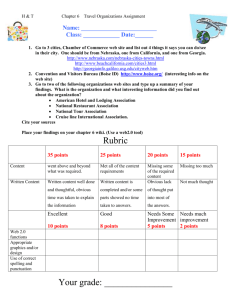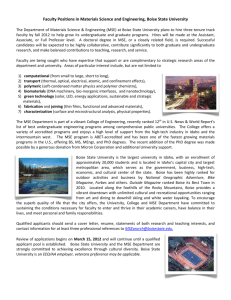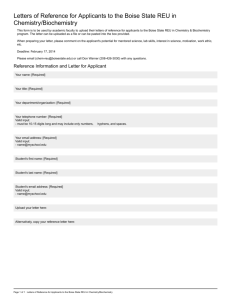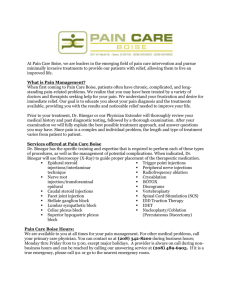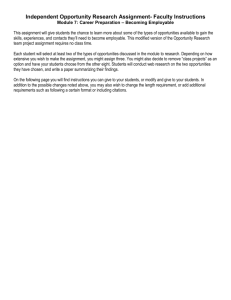Marketing Research for the Boise Public Library
advertisement
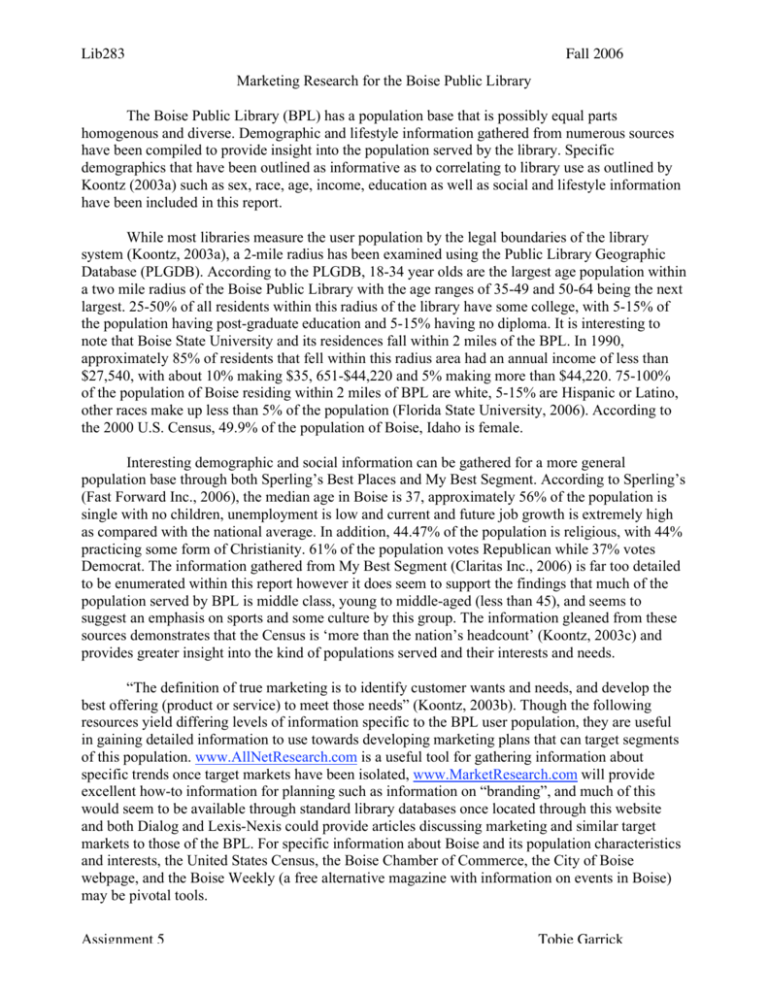
Lib283 Fall 2006 Marketing Research for the Boise Public Library The Boise Public Library (BPL) has a population base that is possibly equal parts homogenous and diverse. Demographic and lifestyle information gathered from numerous sources have been compiled to provide insight into the population served by the library. Specific demographics that have been outlined as informative as to correlating to library use as outlined by Koontz (2003a) such as sex, race, age, income, education as well as social and lifestyle information have been included in this report. While most libraries measure the user population by the legal boundaries of the library system (Koontz, 2003a), a 2-mile radius has been examined using the Public Library Geographic Database (PLGDB). According to the PLGDB, 18-34 year olds are the largest age population within a two mile radius of the Boise Public Library with the age ranges of 35-49 and 50-64 being the next largest. 25-50% of all residents within this radius of the library have some college, with 5-15% of the population having post-graduate education and 5-15% having no diploma. It is interesting to note that Boise State University and its residences fall within 2 miles of the BPL. In 1990, approximately 85% of residents that fell within this radius area had an annual income of less than $27,540, with about 10% making $35, 651-$44,220 and 5% making more than $44,220. 75-100% of the population of Boise residing within 2 miles of BPL are white, 5-15% are Hispanic or Latino, other races make up less than 5% of the population (Florida State University, 2006). According to the 2000 U.S. Census, 49.9% of the population of Boise, Idaho is female. Interesting demographic and social information can be gathered for a more general population base through both Sperling’s Best Places and My Best Segment. According to Sperling’s (Fast Forward Inc., 2006), the median age in Boise is 37, approximately 56% of the population is single with no children, unemployment is low and current and future job growth is extremely high as compared with the national average. In addition, 44.47% of the population is religious, with 44% practicing some form of Christianity. 61% of the population votes Republican while 37% votes Democrat. The information gathered from My Best Segment (Claritas Inc., 2006) is far too detailed to be enumerated within this report however it does seem to support the findings that much of the population served by BPL is middle class, young to middle-aged (less than 45), and seems to suggest an emphasis on sports and some culture by this group. The information gleaned from these sources demonstrates that the Census is ‘more than the nation’s headcount’ (Koontz, 2003c) and provides greater insight into the kind of populations served and their interests and needs. “The definition of true marketing is to identify customer wants and needs, and develop the best offering (product or service) to meet those needs” (Koontz, 2003b). Though the following resources yield differing levels of information specific to the BPL user population, they are useful in gaining detailed information to use towards developing marketing plans that can target segments of this population. www.AllNetResearch.com is a useful tool for gathering information about specific trends once target markets have been isolated, www.MarketResearch.com will provide excellent how-to information for planning such as information on “branding”, and much of this would seem to be available through standard library databases once located through this website and both Dialog and Lexis-Nexis could provide articles discussing marketing and similar target markets to those of the BPL. For specific information about Boise and its population characteristics and interests, the United States Census, the Boise Chamber of Commerce, the City of Boise webpage, and the Boise Weekly (a free alternative magazine with information on events in Boise) may be pivotal tools. Assignment 5 Tobie Garrick Lib283 Fall 2006 Future Research at Boise Public Library With a limited budget, numerous low-cost, yet highly effective research tools can and should still be implemented by the library. Future research should include; Qualitative Research – Focus Groups – Benefits of focus groups can include the ability to gain information from a moderate number of people at the same time, the provision of a comfortable, less-formal environment for respondents to answer questions, and the fostering of more natural discussion rather than more formal interview. Some weaknesses inherent to Focus Group research are the ability to schedule an appropriate group of target market members at times that suit their needs, concerns that group pressures may influence the results, whether negatively or positively, locating and paying a “leader” trained in stimulating the focus group and keeping them on-track. Experimentation – One of the major strengths of experimentation is the ability to test-run products, services or ideas, in a small, pilot version. This method of research allows us to see the marketing program in action and to view and learn from the users’ reactions to this. Some drawbacks may be the temptation to do this on too grand a scale, and the temptation to skip the important experimental processes that make it a useful and scientific tool. Piggybacking – This method may be of particular use to public libraries through surveys conducted by cities and counties. One of the major strengths of this kind of research is perhaps the most obvious – it is usually free. There are however numerous drawbacks. Inability to control who the respondents are or even perhaps the exact nature of the questions, The reliance on other entities to ensure the survey (or other research product) is conducted properly and the information is gathered is compiled and distributed appropriately. Student Projects – An excellent research resource that gives back to the students as well as helping meet the libraries research needs. Strengths include the outsourcing of a large portion of the workload, providing meaningful projects to students. Some of the weaknesses of this approach to research include some students viewing projects as “a grade” and not contributing as fully as a professional might, lack of experience on behalf of the students, short time-frames and tight time constraints (this may be a weaknesses or a strength). Many of these weaknesses can be addressed by working with the students, emphasizing the importance of the work they are doing (getting their buy-in by marketing the program to them) and working with instructors to ensure consistency. A combination of research using secondary sources such as he PLGDB, Census information and resources like “My Best Segments”, primary resources; gathering information specific to the marketing plan such as experimentation and focus groups, and the use of library-collected statistics including circulation and use stats can provide a firm base of research upon which target markets and strategic marketing can be planned and implemented. Boise Public Library should continue to research general customer-base demographic information, information about the interests of user populations and those of potential users and user perceptions of proposed services, resources and products to best meet the needs of the right people at the right time, in the right place at the right price. Assignment 5 Tobie Garrick Lib283 Fall 2006 References Andreasen, A.R. & Kotler, P. (2003). Strategic Marketing for Non Profit Organizations. 6th ed. New Jersey: Prentice Hall. Claritas Inc. (2006). My Best Segment. Retrieved September 21, 2006 from http://www.claritas.com/MyBestSegments/Default.jsp Fast Forward Inc. (2006). Sperling’s Best Places. Retrieved September 21, 2006 from http://www.bestplaces.net/ Florida State University, College of Information. (2006). Public Library Geographic Database. Retrieved, September 20, 2006 from http://www.geolib.org/about.cfm Koontz, C. M. (2003a). Census Data: Valuable Information on Your Library’s Customers. Marketing Library Services, 17. Koontz, C. M. (2001). Marketing Research is a Useful Tool for Libraries. Marketing Library Services, 15. Koontz, C.M. (2003b). A Treasure Trove of Public Library Customer Data in a Geographic Database. Marketing Library Services, 17. Koontz, C. M. (2003c). Understand US Census Data to Improve Your Library’s Marketing. Marketing Library Services, 17. United States Census. (2000). Quick Facts. Retrieved September 21, 2006 from http://quickfacts.census.gov/qfd/states/16000.html Assignment 5 Tobie Garrick
